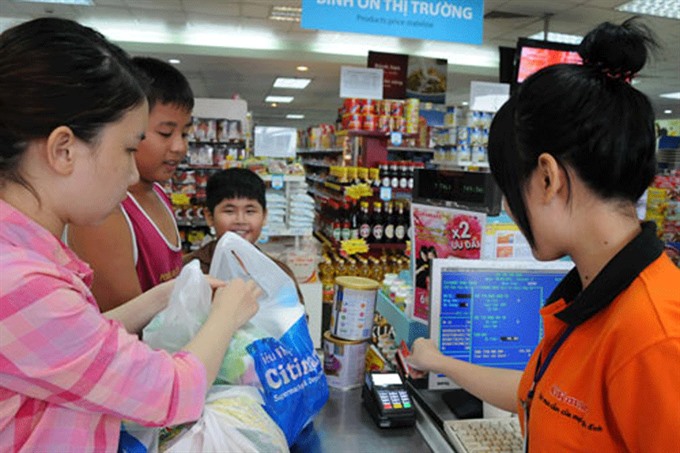 Business Beat
Business Beat

The Prime Minister recently ratified a project to stimulate non-cash transactions in 2016-20 with a view to reducing the cash transactions rate to under 10 per cent.
 |
| The number of bank cards has increased to around 111 million now, according to a Central Bank report. — Photo baogialai.com |
by Thiên Lý
The Prime Minister recently ratified a project to stimulate non-cash transactions in 2016-20 with a view to reducing the cash transactions rate to under 10 per cent.
The project aims to accelerate e-commerce and implement the Master Scheme on E-commerce Development.
All supermarkets and modern distribution centres will take part in e-commerce while 70 per cent of water, electricity, telecom payments will be in non-cash mode. Half of all individuals and households will switch to non-cash transactions.
New, modern means of payments will be developed in rural and remote areas, financial inclusion will be targeted and at least 70 per cent of people aged over 15 will have bank accounts by 2020.
These targets were outlined based on encouraging achievements in the last six years, which have gradually made non-cash payments a trend in Việt Nam.
Cash payments as a ratio of total payments have declined from 14.02 per cent in 2010 to 12 per cent now.
According to a State Bank of Việt Nam report released recently, there are currently around 67.4 million bank accounts compared to 16.8 million in 2010.
Modern infrastructure and technology to facilitate non-cash payments, especially online payments, have developed significantly. The number of bank cards has increased to around 111 million now.
There are around 254,000 points of sales (POS) and 17,380 automatic teller machines (ATMs), up 13.77 per cent and 5.39 per cent since the end of 2015.
The central bank has also rolled out policies related to modern infrastructure and technology to boost non-cash payments, protect customers’interest and ensure service quality.
It has instructed banks to quickly convert all magnetic cards into chip cards to prevent fraud. It wants all ATM cards to become EMV-standard chip cards by 2020 to reduce the risks involved in e-commerce for both buyers and sellers.
But analysts, while not denying the recent accomplishments, still have doubts about the cash-use target.
They said cash was used in nearly 90 per cent of all transactions, and there were only three years left to reduce that to below 10 per cent.
The biggest hindrance to achieving the target is the people’s cash habit, with not only individuals but even businesses yet to get used to non-cash transactions.
For instance, the facility to pay taxes online has been in place since 2014 and 95 per cent of all enterprises have registered for it, but many do not use it.
Besides, this remains an alien concept to the millions of business households and private individuals.
Although e-commerce has developed rapidly in Việt Nam, a majority of buyers still opt for cash on delivery (COD).
According to the Department of E-commerce and Information Technology, many still prefer COD partly due to their habit and partly because they do not fully trust e-commerce websites.
Only around 4.5 million people have applied for e-payment of electricity bills, a mere 18.47 per cent of the total number of users in the country, according to Electricity of Việt Nam.
Banking insiders said most supermarkets, commercial centres and other modern retail sites accepted cards.
Meanwhile, by October last year, 90 per cent of urban people possessed cards, with the total number of cards reaching 110.8 million.
But the number of users was very modest at just 15 per cent .
One of the reasons is that though a huge number cards have been issued, the location of ATMs is skewed in favour of major cities while 70 per cent of the country’s population lives in rural areas.
Another reason is the lack of security, which makes people apprehensive about non-cash payment methods.
A spokesperson for the Commerce Development Research Institute pointed out that the habit of cash payment remains widespread, especially in rural areas.
Besides, the interest rate and fees on credit on credit cards are astronomical, which also makes people reluctant to use them.
To ensure that the PM’s non-cash payment plan can be achieved on schedule, all these problems must be resolved immediately, analysts said.
S Koreans dominate VN entertainment industry
Executives of Multimedia Joint Stock Company have been very busy working with some major partners from South Korea.
They include YG Entertainment, which manages many of Korea’s biggest stars like Big Bang, 2NE1, PSY, Epik High, Choi Ji Woo, Black Pink and Lee Jong Suk, its subsidiary YGKplus, the country’s leading modelling agency, and Naver.com, the country’s biggest search engine and online media and entertainment channel.
The Korean companies are seeking to tie up with Multimedia JSC in entertainment and fashion.
They will send their stars to participate in major entertainment events in Việt Nam like the Vietnam International Fashion Week and also create opportunities for Vietnamese models in Korea.
Besides YG Entertainment and Naver.com, many other Korean companies in movies, the media and entertainment also have plans to enter the Vietnamese entertainment market.
The Việt Nam Film Distribution Association said the market was dominated by foreign distributors, many of them Korean.
Việt Nam now has more than 50 cinema chains. Korean-owned CJ CGV Việt Nam is the largest in the market with 30 cinemas in 10 major cities. Lotte Cinema, also owned by South Korea, has 16 cinemas.
A CJ CGV executive said each year the company opened around 10 cinemas in Việt Nam and expected to reach 60 by next year.
Market observers said South Korean investors saw plenty of opportunities in the Vietnamese entertainment industry.
They find that the Vietnamese entertainment market is still in a fledgling state while the demand for entertainment has skyrocketed in step with living standards, meaning the sky could be the limit for investors.
The fact that Việt Nam and Korea have many cultural similarities means Korean entertainment investors with their quality products can attract Vietnamese audiences easily.
On the commercial side of things, there are several trade agreements Việt Nam has signed which offer opportunities to foreign investors, including those in the entertainment industry.
Analysts said all this meaned pressure on domestic entertainment companies, who could lose the market completely to the Koreans if they were slow to react.
In 2005 CJ CGV and Vietnamese company VIFA established a joint venture called CJ-VIFA whose first project was the drama “Mùi Ngò gai”.
Then CJ CGV bought out Megastar, the largest chain of cinemas in Việt Nam at that time. At the beginning of 2014, after closing the acquisition, Megastar was renamed CGV.
CGV now accounts for over a half the Vietnamese cinema market.
It also dominates the film import market, and by showing more movies than its rivals, including blockbusters, CGV has become popular among the public.
CJ CGV’s strategy is a vital lesson for local entertainment companies. — VNS